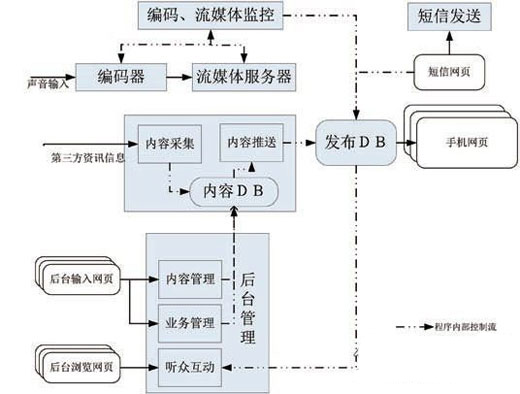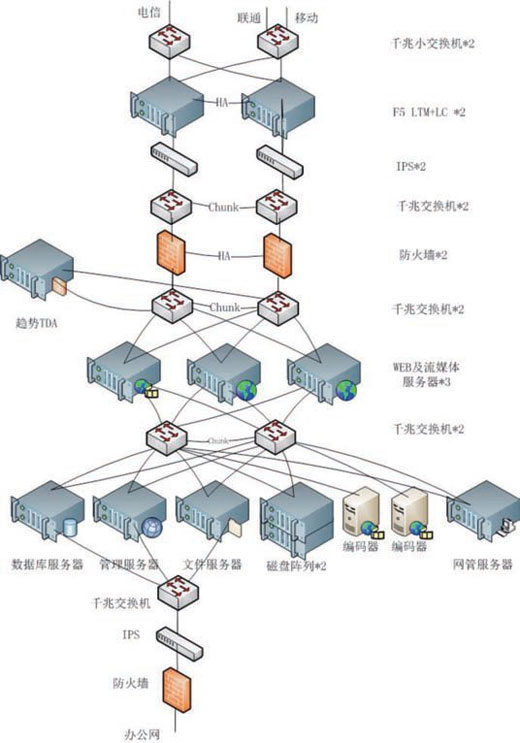50hz to 60hz frequency converter.50hz to 400hz Frequency Converter Frequency Inverter,Frequency Converter,Static Frequency Converter,Voltage And Frequency Converter Jinan Xinyuhua Energy Technology Co.,Ltd , https://www.xyhenergy.com
Therefore, the key to the future development of broadcasting is mainly to build and integrate new media platforms such as mobile Internet broadcasting, websites and digital broadcasting in the operation of the original broadcasting frequency to realize the transformation from single revenue to multi-revenue mode. While transforming to multimedia content providers and operators, we will also accelerate the expansion of various new media businesses with the concept of “operating mediaâ€, and integrate marketing with traditional media and new media business operations to expand profitability and expand profitability. , achieve economies of scale through a variety of media synergies.
The mobile Internet broadcasting service described in this paper is a new broadcasting service mode generated by combining mobile communication networks with broadcasting services. For us, mobile Internet broadcasting can make the traditional broadcasting business more close to the audience, thus getting rid of the inherent mode of traditional advertising channels and creating new advertising revenue growth points for traditional broadcasting; mobile Internet broadcasting does not only mean achieving Profit, more importantly, it can solve the original coverage problem of the broadcast, so that the area that the original FM signal cannot be covered by the subway can listen to the broadcast through the access of the mobile network.
Second, the system program 1, the overall idea

System logic diagram
The mobile internet broadcasting system is composed of a plurality of modules, such as a streaming media service system, a content collection and pushing module, a short message module, a monitoring module, a background management, and a front page publishing.
2, system topology

Topology description
The system infrastructure has applied for multiple external network egresses. The egress switch uses VLAN technology to forward traffic from different egresses to the active and standby load balancing devices. The load balancing function of the load balancing device is used to direct traffic to the corresponding server. Load balancing goes in, providing IDC secondary protection by deploying IPS and firewalls, and filtering harmful data streams hierarchically. At the same time, the combination of the firewall DMZ and the intranet switch VLAN provides security filtering of traffic between VLANs, and then includes background applications associated with the VLAN. The three front-end servers realize virtualization of the system by deploying virtualization and making full use of hardware resources. Balance load application resources with F5 load balancing devices. The background switch between the server and the server realizes the server's mutual access to the encoder and the storage of the storage resource by the server.
3. Introduction to system modules (1) Streaming media service <br> The streaming media server is mainly composed of storage devices, media service devices and load balancing devices. The streaming media server reaches:
· Streaming media content, able to provide streaming media services directly to users;
· Support existing mainstream media formats and streaming protocols (HTTP, RTP, RTSP, RTCP);
Support multiple streaming media rate and support hybrid deployment of different streams on the same device;
· Supports the function of playing while buffering;
· Support partial cache function;
· Perform local load balancing processing on requests for content access to the node, and select to provide services on the most suitable service device;
· Single server can support concurrent users not less than 500 (can be adjusted according to network conditions);
· The live server supports real-time encoding, and the single-live server input is no less than 4 channels;
· Redundancy and error control of the distribution data stream;
· Support flow to promote authentication and monitoring authentication.
(2) Streaming media management <br> Streaming media playback and linking are controlled by webpage programs, and can be switched in real time between multiple streaming media servers. The switching policy is the priority with the least number of links between multiple streaming media. And the effective switching time is within 5 seconds.
The management, status and number of links of the streaming media are controlled by the monitoring program, which can add and delete valid streaming media playback addresses. It can query and record the status of streaming media and the number of links in real time. At the same time, the monitoring data will serve as the basis for the web program to switch streaming media.
(3) Audio coding <br> The encoder consists of a workstation, an audio code card and a set of coding software.
· The current encoding software uses the AAC encoding protocol and supports the RTP (UDP) transport protocol;
· Supportable sampling rates: 8000, 16000, 22050, 24000, 32000, 44100;
· Supportable code rate: 32k, 40k, 48k, 56k, 64k;
· Input: The encoding software can support up to 6 code cards for real-time encoding and output;
· Output: The encoding software supports single-channel encoding single-channel real-time output, and supports real-time query of status information (obtained by Http protocol stack).
(4) Web service <br> At present, the data acquisition of the mobile phone broadcast application is realized by means of webpage access. Therefore, the webpage service module in the system mainly completes the application acquisition of the business data. Currently, the webpage provides three types of business content:
Broadcast: Display broadcast programs in real time; display information about related programs: broadcast time, host photo, program introduction, program reminder.
·Interaction: Provide interactive functions such as paying attention to the program (focusing on the program microblog), participating in comments, and participating in voting.
·Information: Display information in real time, 20 pieces of scrolling information are displayed each time, and 20 items are heard. After clicking Get More, the current column information shows more 20 items, and the current column displays up to 100 pieces of information.

Page service presentation
(5) Monitoring module <br> The monitoring module is mainly responsible for monitoring the status of streaming media services and encoders in the system and recording related information. You can add and delete streaming media servers to be monitored and encoders corresponding to streaming media servers through the configuration management interface. The monitoring module queries the current streaming media server status (including the recording status, startup time, number of currently linked users, cumulative number of linked users) and the running status of the encoder in real time, and records the information data after the query to the local system log in real time. The front-end web service will automatically switch to the streaming server based on the system threshold.
(6) SMS module <br> The SMS module is actually a WEB SERVICE service for mobile web applications. Its main function is to register and use the mobile phone operation website, and call the interface to complete the mobile phone short message authentication service for the user. After the module completes the sending of the short message, the operating system will activate the user status, so that the registered user can log in to the mobile phone operating website. The specific workflow is as follows: the webpage program calls the short message module, and inputs two parameters of the user ID and the mobile phone number; the short message module generates a random password, and sends a short message by calling the short message cat and the mobile short message platform; after the short message cat and the mobile short message platform send the short message successfully, Backfill the random password to the system database for use by web applications. There are currently 2 ways to implement SMS sending function, namely SMS cat and mobile SMS platform. The SMS module automatically switches the relevant sending module according to the system deployment (system configuration file).
(7) Background Management Module <br> The background management module is mainly divided into content management, business management and other two categories of content management and query functions.
· Information management module: including information addition, modification, deletion; information content can be displayed in tabular form; detailed display of the page's single information complete content display function; the information information is added to the push list function.
· Discussion topic management module: including new, modified, and deleted discussion topics; discussion topic content can be displayed in tabular form; set default voting topic, the topic cannot be deleted; add and delete voting items associated with the discussion topic; List of program listings, modify and add related voting topics.
· Host management module: including the host's new, modified, delete; host content can be displayed in tabular form.
· Frequency management module: including the addition, modification and deletion of frequency (including program information); frequency content can be displayed in tabular form; function of adding frequency information to push list; modifying and adding the function of associated voting topic.
· Interactive management module: including obtaining all the comments and voting status queries; summarizing the statistical results in real time.
·Advertising management module: including the addition, modification and deletion of advertisers and advertisements; advertisement-related content can be displayed in a tabular form; the function of adding advertisement information to the push list.
· System user management module: including system administrator's addition, modification, and deletion; system administrator content can be displayed in tabular form; new, modified, and deleted registered users; registered user content can be displayed in tabular form.
·Log management module: The function including the background operation log can be displayed in tabular form; the background operation log can be queried separately according to the operation type, the start termination time and the user account.
Third, the key technology <br> This project mainly studies the real-time audio streaming technology, including the acquisition, encoding, transmission and quality control of real-time audio, as well as the control of safe broadcast and redundant processing.
Realize fast and efficient transmission of encoded audio data, use RTP protocol to encapsulate audio streams and distribute them to different streaming media nodes. RTP is based on the application layer protocol over UDP protocol, and UDP protocol is based on none. Connection mode, so the distribution speed is very fast, RTP encapsulates the structure required for related audio and video transmission, built-in FEC forward error correction technology for data packets, thus verifying the integrity of the data packet and distributing it to the streaming media node After that, the streaming media server receives the real-time audio stream and completes the audio playing function.
· Audio coding has less impact on system resources. Therefore, the encoder can support 6-channel encoding at the same time. The AAC encoding technology with high complexity is used to compress the real-time audio stream to the maximum extent, and can manually adjust different according to the actual network environment. Various parameters such as code rate and sampling rate.
· For the redundant processing of secure broadcast, the administrator can verify the administrator identity and IP address when managing the streaming media server. The streaming server needs to authenticate the identity of the sender while receiving the push stream. The licensed audio content enters the playout system.
The playback end buffers the data stream and automatically controls the buffer size according to different network environment conditions, so that the buffer is reasonably utilized, thereby achieving buffered playback of the audio stream.
IV. Applications and Prospects <br> Mobile Internet Broadcasting System Construction is a huge and complex project. In the project, we always meet the requirements of broadcasting in the future development of mobile Internet, and take the best comprehensive balance of security, reliability and scalability as the guiding principle, and strive to build the system into an industry benchmark. .
The project uses advanced and unique characteristics in the system structure and process design, and explores the new technology concept of mobile Internet broadcasting, and the external operation of mobile Internet broadcasting system will generate great social benefits and economy. benefit. Mobile Internet broadcasting surpasses the limitations of geography, time and computer terminal equipment, and shows the unparalleled advantages of traditional media in terms of communication efficiency and acceptance conditions. With the help of new media functions, it realizes cross-media communication through the combination and interaction of online media and radio stations, which has injected new impetus into the development of broadcasting.
For radio stations, mobile Internet broadcasting has expanded the new development space of broadcasting and increased the extension of programs. At the same time, mobile Internet broadcasting has developed new business opportunities, and it is a technological innovation. The direct beneficiaries are the vast majority. Broadcast the audience.
[Audio Network Information] I. Background <br> At present, most FM/AM radio stations rely on advertisers for their economic resources. The technical limitations of the traditional broadcast mode have led to the development of the broadcasting industry. Due to the technical characteristics of the analog broadcast mode, digital transmission and transmission of broadcast programs cannot be realized at present. Without the digital control of the program, it is difficult to realize the fee management of the audience, so it is relatively simple from the business model, and can not meet the individual needs of the audience and the two-way interaction. With the emergence of new media technologies, new media advertising marketing has its own competitive advantages such as accuracy, high data visibility, direct and interactive, which cannot be replaced by traditional broadcast media. The diversity of new media business forms has led to a decline in the influence of traditional broadcasting services.
March 17, 2024